Applications of Edge Computing
Author: Saadhana Srinath
8.1 Introduction to UIoT and AUVs[edit]
The Underwater Internet of Things (UIoT) is an extension of the Internet of Things (IoT) to the aquatic environments, enabling seamless data collection, communication, and automation beneath the ocean’s surface. It represents a transformative shift in marine technology. UIoT systems basically consist of interconnected smart devices—such as sensors, autonomous vehicles, and underwater drones, that monitor and interact with underwater ecosystems in real time. And unlike terrestrial IoT, which uses stable radio-frequency (RF) communication, UIoT systems operate in an environment where traditional wireless signals do not function, and energy efficiency is critical due to limited power sources.
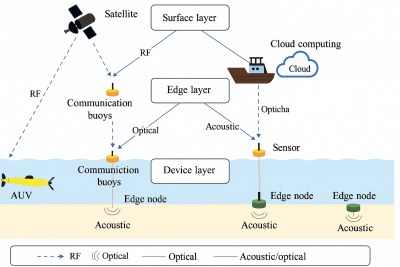
8.1.1 Key components of UIoT[edit]
- Underwater Sensors to measure parameters like temperature, salinity, pressure, and pollution levels depending on the purpose of that particular UIoT device.
- Underwater Communication Networks: Use acoustic, optical, or hybrid signals to relay data.
- Edge Computing Nodes: Enable localized data processing to reduce reliance on distant cloud servers.
- Autonomous Underwater Vehicles (AUVs): Systems designed for marine exploration, mapping, environmental monitoring, and industrial inspections. AUVs are the most important components since they carry all of the other components.
8.1.2 Automated Underwater Vehicles (AUVs)[edit]
AUVs are unmanned, self-guided, programmable submersibles that can function without tethers or real-time human control. Considering the unpredictable nature of marine environments, AUVs are used for deep-sea missions where human presence is either impossible or impractical. Here are a few such scenarios:
- Scientific Research: Mapping seabeds, studying marine biodiversity, and tracking climate change effects.
- Industrial Inspections: Maintaining offshore oil rigs, pipelines, and fault detection in underwater cables.
- Defense & Security: Detecting and neutralizing underwater explosives, surveillance, and submarine reconnaissance.
- Disaster Response: Assessing tsunami or oil-spill damage and aiding search-and-rescue operations (particularly for crashed aircrafts).
Unlike remotely operated vehicles (ROVs), AUVs operate independently, leveraging onboard edge computing to process data without constant human intervention.
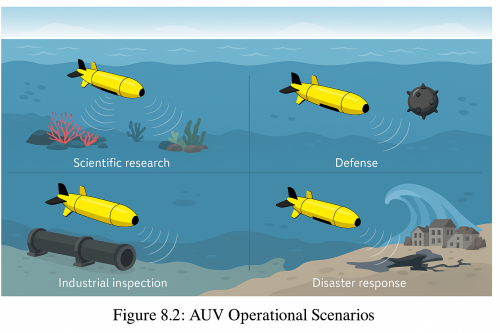
8.1.3 Unique Challenges in Underwater Environments[edit]
Surely, UIoT offers great potential. But it is equally problematic while deploying UIoT and AUVs. Here are the four fundamental challenges:
- Limited & Unreliable Communication
- Unlike terrestrial IoT which uses radio waves for communication, UIoT cannot use radio waves because the strength of radio waves decreases rapidly underwater. This makes RF signals nearly unusable beyond shallow depths and long-range communication is out of the question. Most UIoT systems tend to rely on acoustic or optical signals with limited bandwidth and high latency.
- Acoustic Signals are the most common method for underwater communication. However, acoustic signals have high latency (seconds to minutes) and low bandwidth (kbps range).
- Optical Signals offer relatively higher speeds but require clear water and precise alignment.
- Unlike terrestrial IoT which uses radio waves for communication, UIoT cannot use radio waves because the strength of radio waves decreases rapidly underwater. This makes RF signals nearly unusable beyond shallow depths and long-range communication is out of the question. Most UIoT systems tend to rely on acoustic or optical signals with limited bandwidth and high latency.
- Severe Energy Constraints
- Usually, AUVs run on batteries and majorly rely on limited onboard batteries. Moreover, battery replacement is impractical in deep-sea missions, making energy-efficiency a key constraint.
- Harsh Environmental Conditions
- AUVs are constructed out of metals and other sensitive substances. Extreme pressure, corrosion and biofouling (effect of saltwater and marine life on machinery) degrade hardware reliability over time. This means AUV would require specialized hardware.
- Computational Limitations
- Unlike cloud servers, AUVs have limited processing power. AUVs would need lightweight AI models for real-time decision-making tasks like obstacle avoidance, etc.
All of these challenges highlight the need for edge computing, which shifts data processing from distant clouds to local AUV systems, reducing latency and energy consumption while enabling real-time responsiveness.
8.2 Edge Computing for AUVs: Benefits and Necessity[edit]
8.2.1 Cloud Computing vs Edge Computing for Underwater Systems[edit]
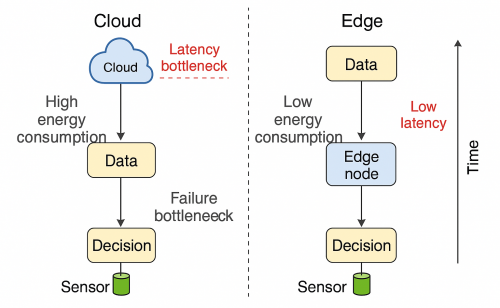
Traditional underwater systems use cloud-based architectures where AUVs collect data and transmit it to surface stations or shore-based servers for processing. But just like everything else that we have discussed in our course, this approach faces serious limitations, particularly in marine environments:
- High Latency: Acoustic signals (the primary underwater communication method as discussed in the previous section) face propagation delays of almost 1.5 seconds per kilometer, making real-time cloud processing impractical for time-sensitive operations like obstacle avoidance.
- Energy Inefficiency: Transmitting raw sensor data needs significantly more power (often 100-1000x more) than local processing, rapidly depleting AUV batteries.
- Intermittent Connectivity: Underwater channels suffer from frequent disruptions due to environmental factors like turbulence, marine life interference, and surface conditions.
Edge computing addresses these challenges by moving computation closer to the data source through:
- Dedicated edge processors (e.g., NVIDIA Jetson, Intel Movidius) installed within AUVs acting as onboard processing units.
- Distributed Edge Nodes (underwater sensor hubs) that pre-process data before selective transmission.
- Systems arranged in a hierarchical architecture that uses device-edge-surface computing
All of these strategies improve real-time decision-making capabilities, energy optimization and operational reliability.
| Parameter | Cloud Computing | Edge Computing |
|---|---|---|
| Latency | 10s-100s of seconds | <100 milliseconds |
| Energy Consumption | High (continuous transmission) | Optimized (local processing) |
| Bandwidth Usage | Maximum (raw data) | Minimal (processed data) |
| Operational Continuity | Dependent on connectivity | Autonomous capability |
| Hardware Requirements | Simple AUV design | Advanced onboard compute |
| Security | Vulnerable in transit | Localized data processing |
8.2.2 Emerging Edge Computing Paradigms for AUVs[edit]
- Federated Edge Learning where multiple AUVs collaboratively train models without sharing raw data. This protects privacy while also improving collective intelligence.
- Edge-Cloud Hybrid Architectures which provide real-time processing at edge for critical tasks and long-term analytics and model refinement is done in the cloud. This method allows flexibility by distributing the workload based on connectivity.
- Neuromorphic Edge Processors: Chips that are inspired by the human brain that offer ultra-low-power AI at depth. This allows event-based processing for sensor inputs that aren’t as regular (for example: fault detecting sensors that are triggered only when there is a breach in a system).
8.3 Challenges of Using Edge Computing with AUVs[edit]
Section 8.1.3 of this chapter outlines the general challenges of implementing IoT in underwater environments—communication barriers, energy constraints, harsh environments, and computational limits. This section provides further analysis of these issues in the context of Edge Computing. It quantifies these challenges and explores solutions for these pproblems.
8.3.1 Unreliable Communication[edit]
Building on the communication limitations introduced in Section 8.1.3, acoustic signals face not only high latency but also severe bandwidth restrictions. Here, we compare alternative technologies (optical/RF) and their tradeoffs.
- Limited Bandwidth & High Latency
- Different communication strategies face different problems underwater.
- Acoustic Communication has extremely low bandwidth (1–50 kbps) and high propagation delay (~1.5 sec/km) because of the low speed of sound underwater. And so, transmitting a 10MB sonar scan could take approx. 30+ minutes. Comparatively, optical communication has high bandwidth (in Gbps), low range (<100m) for transmission and requires clear water. Radio frequencies have an even limited range (<10m) and can only work in shallow waters.
- Intermittent & Unreliable Links
- Apart from bandwidth and latency issues, there are also problems such as surface wave disruptions due to which communication buoys lose connectivity in rough seas and dynamic topology (caused by constantly moving AUVs) leading to frequent network reconfigurations.
8.3.2 Energy Constraints[edit]
AUVs operate on limited battery capacity (typically 1–10 kWh), making energy management critical. This subsection details optimization techniques like adaptive sampling and model compression for energy efficiency.
Transmitting 1MB of data acoustically consumes approx. 10–100 Joules, 100x more energy than local edge processing (0.1–1 Joule).
Energy Optimization Strategies
- Adaptive Sampling: Edge AI triggers high-resolution sensors only when anomalies detected
- Model Compression: Quantized neural networks (e.g., TensorFlow Lite) reduce CPU usage by 4–10x
- Dynamic Voltage Scaling: Processors throttle performance based on mission phase
8.3.3 Harsh Environments[edit]
This section further builds upon the environmental challenges discussed in section 8.1.3. Edge Computing particularly amplifies these challenges due to thermal, mechanical, and operational constraints.
- Thermal Management in AUVs
- Edge processors generate 5–50W of heat in sealed AUV hulls, creating thermal gradients that directly affect the lifespan of components.
| Parameter | Impact |
|---|---|
| Heat Density | 10–100x higher than passive systems |
| Heat Dissipation Rate | 80% slower than air-cooled designs |
| Temperature Fluctuations | ±20°C during compute bursts |
- This can be handled using Phase Change Materials (PCM) such as paraffin wax to absorb the heat during heavy computation. One other common method of handling excess heat is through liquid cooling loop where a dielectric fluid circulates through titanium channels. There's also the method of Thermoelectric Harvesting which converts waste heat and powers low-energy sensors with it.
- > Case Study: WHOI’s Orpheus AUV limits hull temperatures to 55°C at 6,000m depth.
- Pressure-Induced Component Degradation
- High-density edge electronics face accelerated failure under extreme hydrostatic pressure (capacitors face capacitance loss, solder joints get microfractures, etc.). This can be prevented using oil-filled pressure cavities and using solid-state tantalum designs.
- Corrosion & Biofouling
- Unprotected copper circuits get corroded 50% faster in deep-sea as compared to the surface. To reduce this effect graphene coatings are used. And to counter biofouling, UV-LED antifouling with 5W arrays are used to inhibit microbial growth on sensors.
- Edge-enabled AUVs suffer severely from a phenomenon known as Galvanic Corrosion. Most AUVs contain unprotected multi-metal (copper, iron, nickel) circuit boards that get corroded 50% faster in deep-sea as compared to the surface. Another major problem is the formation of natural Microbial Fuel Cells (MFC) on electrical components caused by microorganisms. This can lead to electron transfers and short circuits. Seawater also gets trapped in dense component arrays and causes crevice corrosion. To tackle all of these problems, there are some advanced protection methods.
- 1. Graphene Nanocoatings reduce corrosion current by almost 89% (MIT Sea Grant trials) and add protective layers (<1μm in thickness) to PCBs.
- 2. UV-LED Antifouling is a process where 5W 365nm arrays are used to inhibit microbial growth while consuming only 0.3% of the system’s energy budget.
- 3. Self-Healing Epoxy resins are used to extend component lifespans threefold in saline environments by releasing corrosion inhibitors when damage occurs.
Edge computing introduces critical thermal/mechanical challenges that require co-design of hardware and marine platforms. All of these techniques aim to enhance the durability of edge systems in harsh underwater conditions while maintaining operational efficiency. The optimal balance occurs at 2,000–4,000m depths using hybrid cooling strategies.
8.3.4 Computational Constraints[edit]
Beyond basic AUV capabilities, Edge computing requires unique processing limitations.
- Real-Time Latency Bottlenecks
Task Max Allowable Latency Typical Edge Performance Obstacle avoidance 100ms 50–80ms (Jetson AGX Orin) Fault detection 500ms 200–300ms (FPGA solutions)
- Memory Limitations
- Most AUV edge systems have 4–16GB RAM vs. cloud servers' 100+GB. This is handled by a technique known as Tensor Slicing where large models are processed in chunks or by using MRAM caches which needs almost 10x lower power than SRAM for frequent data access.
These constraints drive innovation in edge solutions, which we explore in Section 8.4 through state-of-the-art architectures like federated learning and hybrid systems.
8.4 State-of-the-Art Edge Computing Solutions[edit]
8.4.1 AI and Edge Processing[edit]
As discussed in the previous sections, AUVs require specialized processing hardware that balances computational power, energy efficiency, and ruggedization for deep-sea environments. This section examines state-of-the-art approaches to implementing AI at the edge in underwater systems, covering hardware platforms, optimized algorithms, and emerging trends in the field.
- Hardware Solutions
- GPU-Powered Systems
- Embedded GPU systems balance computational performance with power efficiency.
- * NVIDIA Jetson AGX Orin (50-200 TOPS) for real-time sonar processing. It performs around 32-200 trillion operations per second (TOPS). In efficiency mode (15W), it can process sonar images at 5-10 frames per second (FPS).
- * Qualcomm QCS6490 has integrated 5G capabilities. This enables AUVs operating near the surface to maintain communication while performing edge processing tasks.
- Field-Programmable Gate Arrays (FPGAs)
- FPGAs can be reconfigured and can be easily adapted to different mission requirements. They combine AI engines with programmable logic, consuming only 8-15W while performing real-time object detection.
- * Use Case: The BlueROV2 platform uses Xilinx Versal ACAP for underwater infrastructure inspection with 95% defect detection accuracy. The Xilinx Versal ACAP runs low-power (8-15W) convolutional neural networks.
- * Intel Cyclone V SoC is another such FPGA that consumes even less power (<5W). It is usually used for swarm AUV applications which require only basic edge processing.
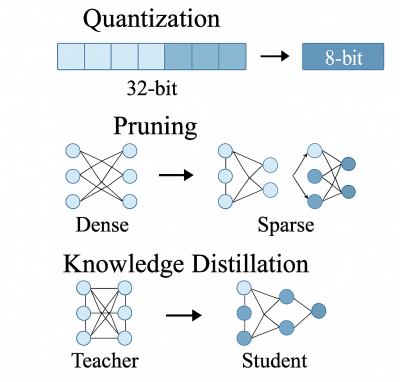
- Software solutions: Optimized AI Models
- Model Optimization
- There are several techniques to optimize factors such as memory usage, power consumption, and accuracy of AI models to fit the constraints of AUVs. Here are a few:
- * Quantization, a technique that reduces numerical precision from 32-bit floating point to 8-bit integers. this leads to a 4x reduction in model size with minimal accuracy loss (<1%).
- * Pruning is the process of removing redundant neural network connections. This eliminates unnecessary parameters while maintaining 95% performance again leading to a smaller model size.
- * Knowledge Distillation is another powerful model size reduction technique where a large "teacher" model trains a smaller "student" model. The smaller model is then deployed reducing model complexity while preserving accuracy.
- Model Architecture
- Recent advances in neural network design have produced several architectures that can be particularly suited for underwater edge applications.
- Apart from model optimization and choosing the right architecture for specific use-cases, certain implementation techniques such as data pre-processing and selective transmission of processed results can be used improve the performance of these AI models.
Case Study: MBARI's Benthic Observer
The Monterey Bay Aquarium Research Institute (MBARI) achieved a 70% reduction in AI power consumption by using some of the strategies discussed above. The Observer uses TensorRT-optimized models with dynamic voltage and frequency scaling and adaptive sampling strategies.
8.4.2 Federated Learning[edit]
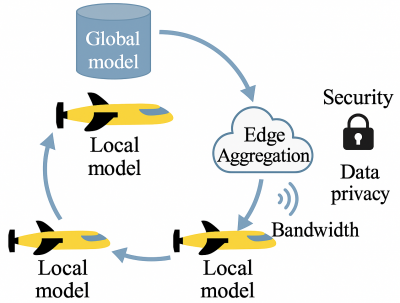
Federated Learning is an ML technique that allows collaborative AI model training across distributed AUV swarms without centralized data collection—a huge advantage for underwater environments where connectivity is limited and data privacy is essential.
Federated Learning systems have a three-tier learning architecture.
- Device Level: This is where local model training and energy-constrained optimization occurs. This level also implements some differential (adding noise to model updates to prevent data leakage) privacy mechanisms to protect data.
- Edge Aggregation Level: This level combines model updates from multiple AUVs using federated averaging (FedAvg). It also flags suspicious model updates (eg, from malfunctioning AUVs).
- Global Updates: This level retrains the global model with edge-aggregated data and marine scientists validate models before redeployment. Additionally, it implements Long-Term Learning where monthly retraining cycles incorporate new oceanographic data.
Federated Learning techniques are known to save energy to upto 42% when compared to centralized training, with 15-20% faster convergence speed and a lower accuracy loss.
Advantages
- Privacy Preservation: Raw data never leaves AUVs (crucial for military/ecological missions).
- Bandwidth Efficiency: Only model updates (not datasets) are transmitted.
- Adaptability: Models improve as more AUVs contribute.
8.4.3 Other Emerging Technologies[edit]
As edge computing evolves further, its incorporation into underwater systems creates opportunities for crazy potential. Several state-of-the-art technologies are starting to use edge processing to improve autonomy, efficiency, and flexibility in underwater environments, going beyond traditional AUV operations and data dumping. Here are a few of such advancements.
- Underwater Swarm Intelligence
- Swarm intelligence is basically multiple AUVs working collaboratively to complete complex tasks. Particularly considering underwater environments, edge computing helps by enabling:
- Real-time data sharing among AUVs
- Distributed decision-making
- Adaptive mission planning
It helps with efficiency and robustness of underwater operations, particularly in dynamic environments.
- Underwater Augmented Reality (AR)
- Integrating AR with edge computing is one of the most interesting tech that is currently being built. It offers better visualization of underwater structures leading to improved navigation for AUVs and real-time overlay of sensor data. This kind of tech would have heavy applications in tasks such as underwater construction, maintenance, and archaeological exploration.
- Edge-Enabled Bio-Inspired Robotics
- Inspired by marine life such as fish, octopuses, and jellyfish, bio-inspired underwater robots are being developed to operate more efficiently in complex terrains. When combined with edge computing, these robots would be able to adapt motion patterns in real-time to navigate turbulent currents, perform distributed sensing using soft, flexible sensor arrays and even execute silent, low-energy operations to avoid disturbing marine life. This would promise the advantage of stealth, mimicking natural organisms and their movements avoids detection and the disruption of the natural ecosystem. These robots could be used for delicate ecological monitoring, covert surveillance, and search-and-rescue missions in fragile environments where traditional AUVs may be too disruptive.
8.5 Future Research Directions[edit]
There is still a lot of room for innovation and research as the relationship between edge computing and AUV technology develops. Even while existing solutions have shown that local processing is feasible and advantageous in underwater environments, there are still a lot of unanswered questions and a wide array of challenges meaning immense research potential. Here are some exciting future directions with a thought to make undersea operations more intelligent, robust, and energy-efficient.
- Energy Harvesting Mechanisms - With an aim to develop sustainable energy sources for AUVs and extend AUV operational time without the need for frequent battery replacements.
- - Harnessing ocean thermal gradients
- - Using microbial fuel cells
- - Exploring kinetic energy from ocean currents
- Advanced Materials for AUVs - This, as we have gone through in the previous sections, could solve a multitude of challenges that come with underwater conditions. Innovations in materials science can lead to:
- - Enhanced corrosion resistance
- - Improved structural integrity under high pressure
- - Reduced biofouling
- Research into nanocoatings and composite materials could increase the lifespan and reliability of AUVs.
References[edit]
- "Underwater Internet of Things in Smart Ocean: System Architecture and Open Issues." IEEE Transactions on Industrial Informatics, vol. 16, no. 7. https://ieeexplore.ieee.org/document/8863935
- "Internet of Things in Marine Environment Monitoring: A Review" https://pmc.ncbi.nlm.nih.gov/articles/PMC6479338/
- "Underwater Acoustic Sensor Networks: Research Challenges." Ad Hoc Networks Journal, 2005. https://www.sciencedirect.com/science/article/pii/S1570870505000168
- "Federated Learning for Underwater Swarm Robotics." arXiv preprint, 2020. https://arxiv.org/abs/2007.14513